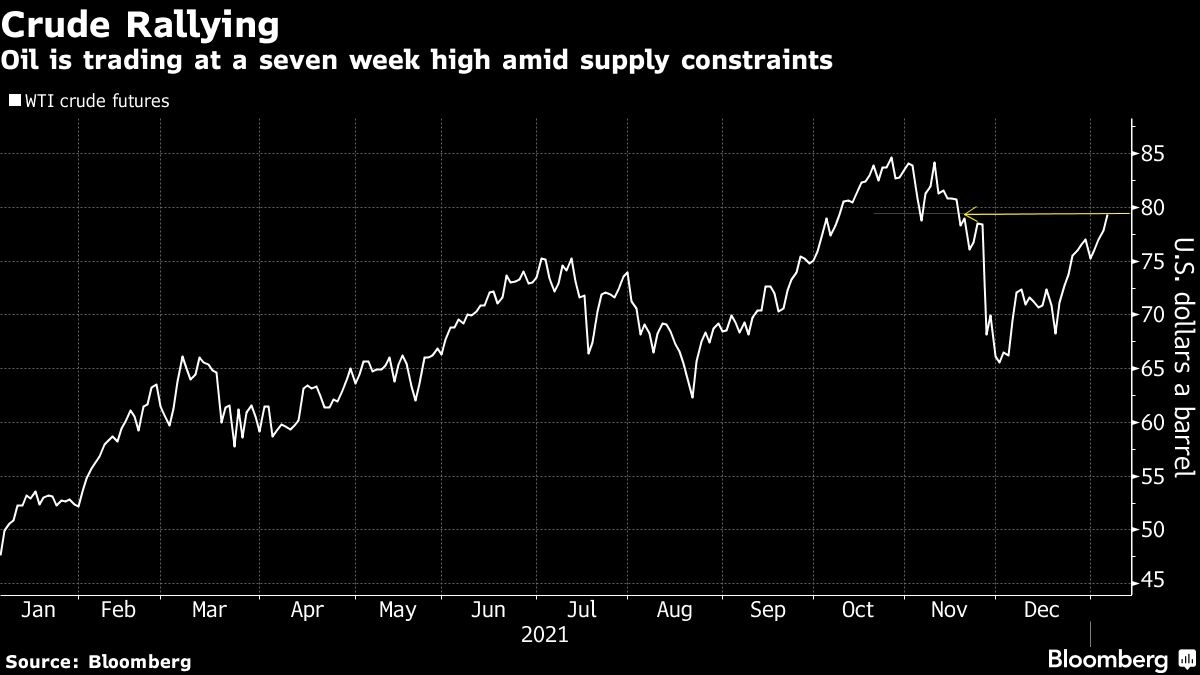Nov 25, 2021
Oil steadies as supply constraints counter Omicron concerns
, Bloomberg News
Oil climbed to a seven-week high as supply constraints from OPEC+ to North America offset concerns about the impact of a COVID-19 outbreak in China.
Futures in New York traded above US$80 a barrel on Thursday, the highest since Nov. 17, before paring some gains. A deep freeze in Canada and the northern U.S. is disrupting oil flows, boosting prices just as American stockpiles decline. Output from OPEC+ member Kazakhstan’s giant Tengiz oil field has been temporarily adjusted amid unrest in the Central Asian country.
A growing premium for prompt barrels suggests that supply troubles across the OPEC+ coalition -- which was able to provide only part of last month’s planned production increase -- are delaying the onset of an anticipated oversupply in global markets. Production in OPEC member Libya is down about 30 per cent amid militia unrest, while Russia failed to boost output last month.

Oil’s “is fueled by demand holding up well in face of omicron, supply disruptions, OPEC+ spare capacity concerns and most importantly sentiment,” said Rebecca Babin, senior energy trader at CIBC Private Wealth Management. “It feels like we are setting up for a blow off to the upside.”
Severe cold temperatures that temporarily prompted shut-ins or slowdowns at oil fields in North Dakota and West Texas have stoked concerns that suppliers won’t be able to meet contractual obligations for the month. Those potential shortages have led to some traders to scour the market for possible replacement barrels, pushing prices higher for grades such as Bakken and West Texas Intermediate crude.
Prices
- West Texas Intermediate for February delivery rose US$1.70 to US$79.55 a barrel at 11:04 a.m. in New York, after earlier trading as high as US$80.24
- Brent for March settlement rose US$1.33 to US$82.13 a barrel
Oil ended 2021 on a strong footing as the rollout of vaccines helped economies to reopen, boosting energy demand and allowing OPEC+ to maintain its gradual monthly output increases. Some members of the group have struggled to meet their targets, however, curbing the overall expected return of supply.
Still, prices face headwinds as China locks down some cities to try and stem the spread of the worst COVID-19 outbreak since the initial flareup in Wuhan.
IHS Markit further lowered its projection for China’s total oil demand in the first quarter of 2022 by 420,000 barrels a day due to restrictions on mobility. Similarly, Energy Aspects Ltd. cut its first-quarter forecast by 110,000 barrels a day, while warning that there may be further reductions if more outbreaks emerge.
Other oil-market news:
- Saudi Arabia cut oil prices for buyers in Asia, signaling that extra supplies from OPEC and its partners could loosen the market amid the rapid spread of coronavirus.
- There’s been a temporary adjustment to output due to logistics at Kazakhstan’s giant Tengiz oil field, amid unrest and protests in the Central Asian country, according to operator Tengizchevroil
- Exxon Mobil plans to halt an alkylation unit at its Gravenchon refinery in March-April, according to a person familiar with the plans.


